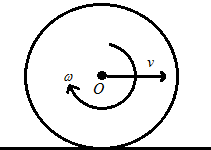Kinetic Energy of Rolling Wheel Energy of a Rolling Body
If an object is rolling without slipping, then its kinetic energy can be expressed as the sum of the translational kinetic energy of its centre of mass and the rotational kinetic energy about the centre of mass.

The translational kinetic energy of a rolling body is:
(K.E)T = ½ mv²
The rotational kinetic energy of a rolling body is:
(K.E)R = ½ I₀ω²
Since we know that I₀ = mk² and for rolling ω = v/ r
\({{\left( K.E \right)}_{R}}=\frac{1}{2}m{{k}^{2}}\left( \frac{{{v}^{2}}}{{{r}^{2}}} \right)=\frac{1}{2}\frac{{{k}^{2}}}{{{r}^{2}}}m{{v}^{2}}\).
Hence, the total kinetic energy of the rolling body (K.E) = (K.E)T + (K.E)R. Putting v = rω for rolling, we obtain the total kinetic energy in terms of ω as:
\(\left( K.E \right)=\frac{1}{2}m{{(r\omega )}^{2}}\left( 1+\frac{{{k}^{2}}}{{{r}^{2}}} \right)\).
(K.E) = ½ (mr² + mk²)ω²
Since, mk² = MI of a body about its centre of mass O = I₀. Hence, mk² + mr² = I₀ + mr² = IP.
Where, IP = MI of the body about P.
Therefore, we conclude that the combined effects of translation of centre of mass of a body and its rotation about an axis passing through the CM are equivalent to its pure rotation about an axis passing through the point of contact P, of the rolling body.
% of energy of translation \(=\frac{{{\left( K.E \right)}_{T}}}{\left( K.E \right)}\times 100=\frac{\frac{1}{2}m{{v}^{2}}}{\frac{1}{2}m{{v}^{2}}\left( 1+\frac{{{k}^{2}}}{{{r}^{2}}} \right)}\times 100=\frac{{{r}^{2}}}{{{k}^{2}}+{{r}^{2}}}\times 100\).
Similarly, % of energy of rotation \(=\frac{{{k}^{2}}}{{{k}^{2}}+{{r}^{2}}}\times 100\).
